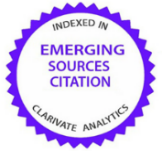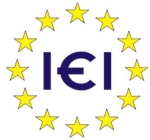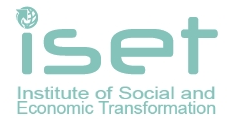Theoretical approach to E-learning quality
Abstract
Introduction. Over the past decade, as technology coupled with the increasingly frequent use of the internet have become the forefront of business and academia, e-learning has emerged on the global higher education stage as a leading means of gaining an education in Higher Education. Because internet-based learning is currently such a relevant topic, inter alia due to the occurrence of the pandemic, there is a dire need for the creation of a common language to proceed in a collectively positive direction regarding the development of a culture of excellence within e-learning. This paper provides a springboard to discuss the underlying issues and challenges related to quality of internet-based learning, including the need for right measuring, and understanding dimensions of e-learning quality.
Aim and tasks. The quality of education needs to be addressed (measured and managed) comprehensively, which means that, in addition to pedagogical aspects, it is also necessary to address the market quality. Therefore, a distinction must be made between quality that meets specifications (standard quality) and quality that meets expectations. Therefore, the main aim of the article is to review the different definitions of quality in e-learning and the dimensions that must be included in measuring the quality of e-learning.
Results. Based on an extensive review of the literature on quality in e-learning, we conclude that the quality of e-learning cannot be viewed only from the student's perspective, but from the point of view of all participants in the e-learning process. In addition to pedagogical aspects, organizational, economic, and legal aspects must also be considered. What dimensions are key to measuring quality in e-learning thus remains a question to be answered.
Conclusions. The quality of e-learning depends on many factors. Despite many discussions about quality and the search for appropriate dimensions of quality in e-learning, there is still no single evaluative standard. Because of this, effective qualitative metrics for e-learning are urgently required.
References
2. Achtemeier, S. D., Morris, L. V., & Finnegan, C. L. (2003). Considerations for developing evaluations of online courses. Journal of Asynchronous Learning Networks (JALN), 7(1), 1–13.
3. Adamišin, P., Vavrek, R., & Pukala, R. (2015). Cluster analysis of Central and Southeast Europe via selected indicators of sustainable development. Environmental Economics, Education and Accreditation in Geosciences: Ecology, Economics, Education and Legislation, 135-140.
4. Ardito, C., Costabile, M. F., De Marsico, M., Lanzilotti, R., Levialdi, S., Roselli, T., & Rossano, V. (2006). An Approach to Usability Evaluation of e-learning Applications. Universal access in the information society, 4(3), 270–283.
5. Barron, J. (2006). Top ten secrets of effective e-learning. Industrial and commercial training, 38(7), 360–364.
6. Cronin, J. J., & Taylor, S. A. (1992). Measuring service quality: a re-examination and extension. Journal of Marketing, 56, 55–68.
7. Ehlers U.-D. & Pawlowski J. (2006). Quality in European e-learning: an introduction. In Handbook on Quality and Standardisation in E-learning (eds U.-D. Ehlers & J. Pawlowski), pp. 1–13. Springer, Berlin, Germany.
8. Ehlers, U. D. (2004). Quality in e-learning from a Learner's Perspective. Retrived February 27, 2021 from http://www.eurodl.org/materials/ contrib/2004/Online_Master_COPs.html
9. Ehlers, U. D. (2007). Quality Literacy — Competencies for Quality Development in Education and e-learning. Educational Technology & Society, 10(2), 96–108.
10. E-learning Advisory Group. (2002). Highways and pathways: Exploring New Zealand’s e-learning opportunities. Retrieved January 14, 2021, from http://cms.steo.govt.nz.
11. Fitzsimmons, J. A., & Fitzsimmons, M. J. (1998). Service Management. Boston: McGraw-Hill.
12. Garvin, D. A. (1991). Barriers and gateways to learning. Education for judgment: The artistry of discussion leadership, 3-13.
13. Holzinger, A., & Motschnig, R. (2005). Considering the Human in Multimedia: Learner Centered Design (LCD) & Person Centered e-learning (PCeL). ISSEP 2005 Conference, University of Klagenfurt.
14. Ivanaj, S., Nganmini, G. B., Antoine, A. (2019). Measuring E-Learners' Perceptions of Service Quality. Journal of Organizational and End User Computing (JOEUC) 31(2). https://doi.org/10.4018/JOEUC.2019040105
15. Jung, I. S. (2008). Quality assurance and continuous quality improvement in distance education. In T. Evans, M. Haughey, & D. Murphy (Eds.), International handbook of distance education (pp. 609–624). London: Emerald Group Publishing Limited.
16. Lapuh Bele, J., Bele, D., & Rozman, D. (2007). Naj bo slika vredna tisoč besed? V V. Rajkovič, T. Urbančič, & M. Bernik (ur.). Vzgoja in izobraževanje v informacijski družbi: zbornik 10. mednarodne multikonference Informacijska družba IS 2007, 12. oktober 2007 (str. 236–243). Ljubljana: Ministrstvo za šolstvo in šport; Institut Jožef Stefan; Zavod Republike Slovenije za šolstvo; Kranj: Fakulteta za organizacijske vede.
17. Laurillard, D. (2002). Rethinking University Teaching. A conversational framework for the effective use of learning technologies. London: Routledge.
18. Lewlyn, L.R., Barkur, G., Varambally, K.V.M., Motlagh, F.G. (2011). Comparison of SERVQUAL and SERVPERF metrics: an empirical study. TQM Journal, 23(6), 629-643.
19. Luchaninova, O., Koval, V., Deforzh, H., Nakonechna, L. & Golovnia, O. (2019). Formation of communicative competence of future specialists by means of group work. Espacios, 40 (41), 11.
20. MacDonald, C. & Donio, J. (2007). Sharing e-learning Evaluation and Quality Measurement Resources. In R. Carlsen, K. McFerrin, J. Price, R. Weber & D. Willis (Eds.), Proceedings of SITE 2007--Society for Information Technology & Teacher Education International Conference (pp. 882-889). San Antonio, Texas, USA: Association for the Advancement of Computing in Education (AACE). Retrieved March 10, 2021 from https://www.learntechlib.org/primary/p/24662/.
21. Marshall, S. (2012). Improving the quality of e-learning: lessons from the eMM. Journal of Computer Assisted Learning, 28(1), 65-78. https://doi.org/10.1111/j.1365-2729.2011.00443.x
22. Masoumi, D., & Lindström, B. (2012). Quality in e-learning: a framework for promoting and assuring quality in virtual institutions. Journal of Computer Assisted Learning, 28(1), 27-41. doi: 10.1111/j.1365-2729.2011.00440.x
23. McLoughlin C. & Lee M.J.W. (2008) The three P’s pedagogy for the networked society: personalisation, participation and productivity. International Journal of Teaching and Learning in Higher Education 20, 10–27.
24. Misut, M., Pribilova, K. (2014). Measuring of Quality in the Context of e-learning. Procedia - Social and Behavioral Sciences, 177, 312 – 319
25. Notess, M. (2001). Usability, User Experience, and Learner Experience. eLearn Magazine, Avgust, 2001. Retrived February 15, 2021 from http://www.elearnmag.org/subpage.cfm?section=tutorials&article=2-1
26. Parasuraman, A., Zeithaml, V. A., & Berry, L. L. (1994). Reassessment of Expectations as a Comparison Standard in Measuring Service Quality: Implications for Further Research. Journal of Marketing, 58(11), 111–124.
27. Parasuraman, A., Zeithaml, V. A., & Malhotra, A. (2005). E-S-QUAL: A Multiple-item Scale for Assessing Electronic Service Quality. Journal of Service Research, 7(3), 213–233.
28. Pukala R., Lysytsia N. M., Prytychenko T. I., Gron O. V. (2018). International Marketing of Economic Educational Services in Ukraine and Poland. Bussines Inform, 9, 77-84.
29. Rubin, Yuri. (2010). Modern E-learning: Qualitative education accessibility concept. Quality Assurance of E-learning. Retrived February 20, 2021 from https://www.enqa.eu/indirme/papers-and-reports/workshop-and-seminar/ENQA_wr_14.pdf
30. Saatz, I., & Kienle, A. (2013). Increasing Quality in large scale University Courses. E-flashcards as an approach to support active learning and individual facilitation. Eleed, 9 (1). https://eleed.campussource.de/archive/9/3655
31. Shaik, N., Lowe, S., & Pinegar, K. (2006). DL-sQUAL: A multiple-item scale for measuring service quality of online distance learning programs. Journal of Distance Learning Administration, IX(II). Retrived February 20, 2021 from http://www.westga. edu/~distance/ojdla/summer92/shaik92.htm
32. Squires, D., & Preece, J. (1999). Predicting Quality in Educational Software: Evaluating for Learning, Usability and the Synergy between them. Interacting with Computers, 11, 467–483.
33. Stella, A., & Gnanam, A. (2004). Quality assurance in distance education: The challenges to be addressed. Journal of Higher Education, 47(2), 143–160.
34. Udo, G. J., Bagchi, K. K., & Kirs, P. J. (2011). Using SERVQUAL to assess the quality of e-learning experience. Computers in Human Behavior, 27(3), 1272-1283. https://doi.org/10.1016/j.chb.2011.01.009
35. Zhang, W., & Cheng, Y. L. (2012). Quality Assurance in E-learning: PDPP Evaluation Model and its Application. The International Review of Research in Open and Distance Learning, 13(3), 66-82. https://doi.org/10.19173/irrodl.v13i3.1181
If the article is accepted for publication in the journal «Economics. Ecology. Socium» the author must sign an agreementon transfer of copyright. The agreement is sent to the postal (original) or e-mail address (scanned copy) of the journal editions.






















